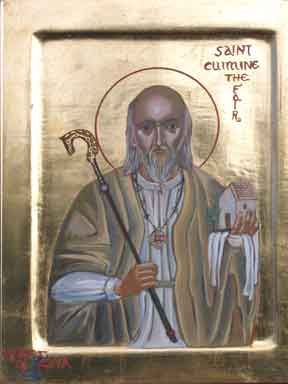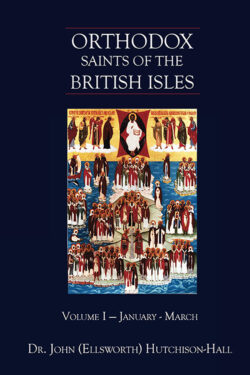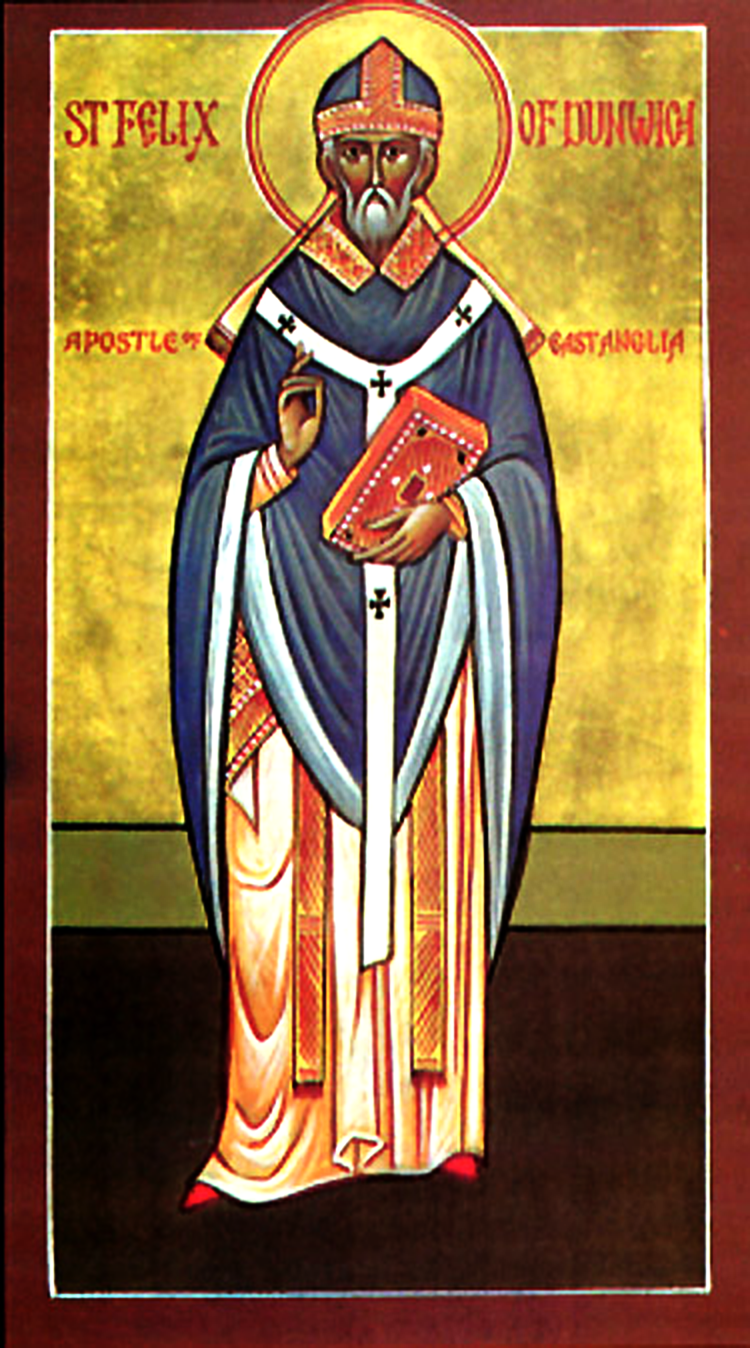
Orthodox Saints of the Pre-Schism
See of Rome
8th March (NS) — 24th February (OS) 2024
ÆTHELBERHT I (ETHELBERT, ALBERT) of KENT, the first Christian English king, St. Æthelberht was married to Bertha of France. King St. Æthelberht welcomed the mission led by St. Augustine of Canterbury (27th May) in 597 and is believed to have been baptised by him that same year. He founded Canterbury and Rochester Cathedrals, as well as St. Paul’s, London. King St. Æthelberht reposed in 616, and was buried in the abbey, which he had also built, at Canterbury.
BETTO, a monk at Sainte Colombe in Sens in Burgundy, who was consecrated Bishop of Auxerre in 889, serving that See until his repose in 918.

Icon of St. Cumméne Albus (Cumine Ailbhe, Cumine the White), Abbot of Iona
CUMMÉNE ALBUS (CUMINE AILBHE, CUMINE the WHITE), (also 6th October), an Irishman who served as Abbot of Iona, St. Cumméne also wrote a Life of St. Columba of Iona (9th June). He reposed in 669.
JOHN THERISTUS (The HARVESTER), having killed his father, Saracens then enslaved St. John’s pregnant mother. They transported her from Calabria to Sicily where St. John was born. In his early teens, St. John managed to escape and travelled from Sicily to Calabria where he received monastic tonsured. Once, when a devastating storm was approaching which would have destroyed the neighbouring crops, St. John miraculously harvested the crop, saving the local community from starvation, and earning the sobriquet ‘Theristus’. St. John reposed in 1129.
LIUDHARD (LETARD), St. Liudhard was the French bishop of unknown See — though Butler, and some others assert that he had been Bishop of Senlis in Picardy — who accompanied Queen Bertha to Kent on the occasion of her marriage to King St. Æthelbert (vide supra). As with so many of his contemporaries, few definite facts are known of his life, though it is safe to assume he did have a role in ensuring the warm welcome given to St. Augustine of Canterbury (27th May) and his fellow missionaries. St. Liudhard reposed circa 600.
MODESTUS, the twenty-first Bishop of Trier from 486 until his repose in 489. He successfully led his flock through the difficult period when the city came under Frankish rule. His relics are enshrined in the church of St. Matthias in Trier.
MONTANUS, LUCIUS, JULIAN, VICTORICUS, FLAVIAN, and COMPANIONS, a group of ten disciples of St. Cyprian of Carthage (16th September), martyred in 259 in the persecution of Christians during the reign of Valerian. The first part of their Acts consists of a prison diary kept by the martyrs, and the second part eyewitness accounts of their martyrdom.
PRAETEXTATUS (PRIX), the seventeenth Bishop of Rouen from 550 to 586. His rebukes of the scandalous behaviour of Queen led to his persecution and exile, though he was reinstalled seven years later. However, he continued to reprimand the Queen who had him assassinated on Easter Sunday 586 on the steps to the altar of his cathedral.
PRIMITIVA (PRIMITIVUS), (Date Unknown), an early martyr in Rome, of whom no further information is extent.
Get your copy of Orthodox Saints of the British Isles today.
Available at Amazon or your favourite e-bookstore.
BEOADH (BEATUS), a Bishop of Ardcarne in Co. Roscommon, Ireland, few facts are known of St. Beoadh’s life. Traditionally he has been renowned for his piety and the miracles that are associated with him. It is believed that he reposed sometime between 518 and 523.
CYRIL, ROGATUS, FELIX, ANOTHER ROGATUS, BEATA, HERENIA, FELICITAS, URBAN, SILVANUS, and MAMILLUS, (Date Unknown), St. Cyril, a bishop, and members of his flock, martyred in North Africa. Nothing is known of them aside from these names.
Troparion of St. Felix of Dunwich
Tone VIII
Felix of Burgundy, hierarch and teacher, preaching the Word of life,
You did gather a rich harvest of believers;
Together with Furzey of Ireland, pilgrim for the love of the Lord,
Outstanding in virtue, renowned in word and deed;
Enlighteners of East Anglia, we rightly praise you, holy and God-bearing fathers.
Kontakion of St. Felix of Dunwich
Tone II
Having come to the land of Sigebert, the righteous king,
You preached the kingdom of Christ our God,
And as a first-fruit the king himself received the tonsure,
Seeking an everlasting kingdom;
And mindful of his monastic vow,
He lay down his life, unarmed in the midst of battle;
Wherefore, O Felix and Furzey, we venerate your memory crying out:
Glory to Christ our King the Redeemer of the World!
FELIX of DUNWICH, a native of Burgundy, who, after converting the then-exiled East Anglian prince who would become St. Sigeberht (25th January), King of the East Angles (r. 630/1–654), made his way to England. Establishing his See at Dunwich in Suffolk, St. Felix laboured there for seventeen years, successfully preaching the Gospel to the heathen in East Anglia. He founded a school for boys with the help of King St. Sigebert, which he staffed with teachers from Canterbury. St. Felix reposed in 648 and was buried at Dunwich; his relics were translated to Ramsey in 971. St. Felix has given his name to Felixstowe in Suffolk, and to Felixkirk in Yorkshire.
HUNFRID (HUMFRIDUS, HUMPHREY), a monk at Prüm Abbey (Fürstabtei Prüm) in Lorraine (present-day Roman Catholic Diocese of Trier, Germany). In 856 Pope Nicholas I promoted a reluctant St. Hunfrid to Bishop of Thérouanne in Gaul. Forced to flee his See during a Norman invasion, St. Hunfrid returned to assist with the city’s restoration and serve as Abbot of St. Bertin Abbey (abbaye Saint-Bertin). St. Hunfrid reposed in 871.
JULIAN of TOLEDO, consecrated the thirty-fourth Archbishop of Toledo in 680, St. Julian presided over several important councils at Toledo, and played a significant role in revising the Mozarabic Liturgy. A prolific writer, St. Julian is best remembered for his Prognosticum Futuri Saeculi (a treatise on Christian Eschatology), and Historia Wambae regis (a history of King Wamba of Spain’s accession to the throne and early reign). St. Julian reposed in 690.
PONTIUS, St. Cyprian’s (16th September) deacon, St. Pontius accompanied St. Cyprian into exile from Carthage in North Africa and witnessed his trial and execution. He later wrote a Life of St. Cyprian. St. Pontius reposed circa 260.
PROVINUS, a disciple of St. Ambrose (7th December) in Milan who served as St. Felix’s (14th July) co-adjutor and, following St. Felix’s repose, Bishop of Como. St. Provinus reposed circa 420.
RHIAN (RANUS, RIAN), (Date Unknown), the saint for whom Llanrian in Pembrokeshire is named. He has been described as an abbot by both, chronicler William of Worcester (†1482) and antiquarian John Leland (†1552). Neither specific dates nor particulars of his life are ascertainable.
SENAN (SENAMES), one of the 'Twelve Apostles of Ireland', St. Senan was a disciple of St. Natalis (27th January) and a monk, possibly an abbot, Cassidus. After finishing his studies, he established a monastery on the Island of Inniscorthy (Leinster), he then visited Rome and Gaul, and on his return spent time with St. David (1st March) in Wales. Returning to Ireland, he founded more churches and monasteries, notably one in Iniscarra near Cork, finally settling on Scattery Island in the Shannon estuary, where he reposed circa 540.
Prior to the Schism the Patriarchate of Rome was Orthodox, and fully in communion with the Orthodox Church. As Saint John of Shanghai and San Francisco +1966 said “The West was Orthodox for a thousand years, and her venerable Liturgy is far older than any of her heresies”.
Details of British Saints excerpted from Orthodox Saints of the British Isles.
Details of continental saints from these sources.
In many cases there are several spelling versions of the names of saints from the British Isles. I use the Oxford Dictionary of National Biography version as the primary version with the more prevalent version in parenthesis e.g. Ceadda (Chad) of Lichfield.


